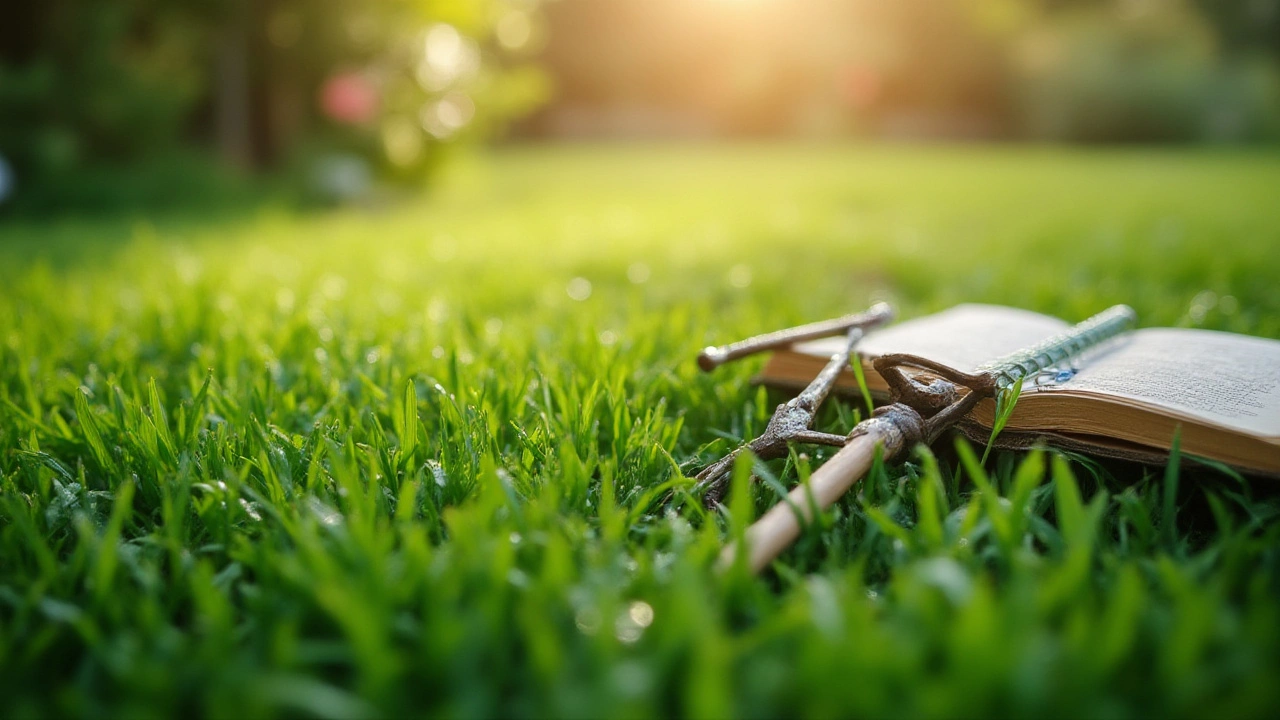You step outside, coffee in hand, and look at your patchy, dull grass. It should be thick, green, and inviting—like the lawns in those home improvement ads. But right now? It’s looking tired, a little embarrassed, and as if it could use a spa day. Here’s the wild part: you don’t need a landscaping crew or fancy gadgets to turn things around. Sometimes, the smallest changes unlock the healthiest, richest grass you’ve ever seen. Want to know why some neighbors’ lawns pop? Stick around.
Understanding What Makes Grass Thrive
Let’s start simple: your grass isn’t being difficult for fun. It’s working with what you give it—sun, water, soil, and whatever you throw on top. Think of grass roots as hungry mouths. They’re particular about what they eat and how often. If your soil is tough as concrete or loaded with clay, roots struggle to grab what they need. A lawn thrives when the soil lets water and nutrients sink down easily. That’s why pros always say, "Feed the soil, not just the plants." Healthy soil means happy, strong grass, able to bounce back from rainstorms or a Saturday’s worth of backyard football.
If you’re seeing thin, pale grass, there’s a solid chance your yard’s not getting enough nitrogen. Grass devours nitrogen, especially in spring and summer. Here’s a fun number: according to the University of Nebraska-Lincoln’s turf experts, cool-season grasses like Kentucky bluegrass do best with about 3 to 4 pounds of nitrogen per 1,000 square feet, each year. That’s not a bucketful, but it’s not nothing either.
Now, sun plays a starring role. Short, pale grass often means not enough light. If your yard’s shaded by thick trees or the neighbor’s fence casts shadows most of the day, you’ll need grass varieties built for shade—like fine fescue. Otherwise, it’s going to be a slog for your lawn to ever look truly lush.
Water: too little and you get brittle, brown patches; too much, you basically drown the roots. Most grass needs one to one and a half inches of water per week. Mother Nature and your sprinklers can tag-team here, but a good rule is deep and less frequent watering. Shallow, daily sprinkles never reach the deeper roots—so grass stays weak and shallow too.
| Factor | Why It Matters | Pro Tip |
|---|---|---|
| Soil Health | Nutrient and water absorption | Test soil every few years |
| Nitrogen | Promotes green growth | Apply in spring and fall |
| Sun | Powers photosynthesis | Trim trees as needed |
| Water | Keeps grass hydrated | Water deeply, once per week |
Remember, the real secret isn’t a mystery solution you haven’t heard of. It’s doing a few basic things, really well, and being consistent—which leads right into the next piece.
Simple Steps for Lush, Green Grass
If you want a lush lawn, start with the basics—all the yard tricks in the world won’t replace mowing, feeding, watering, and fixing the soil. Here’s the clear roadmap to better grass, whether your lawn’s big or tiny:
- Test your soil first. This gives you the winning edge. A home kit, available at garden centers, reveals if your soil’s missing anything (like nitrogen, phosphorus, or potassium). You might discover your soil’s a bit acidic or way too alkaline. Grass likes the sweet spot between 6 and 7 on the pH scale. If things are off, garden lime (to raise pH) or sulfur (to lower) can fix it.
- Feed it well—but not too much. Most lawns like feeding twice a year: once in early spring, then again in fall. Use a slow-release fertilizer. Too much at once burns your lawn and messes up the soil, causing uneven growth.
- Raise the mower blade. Short grass stresses quickly. Letting it grow a little longer (around 3 inches) keeps roots shaded and cool. Taller grass chokes out weeds too—no chemicals needed.
- Water smarter, not more. Deep water once or twice a week beats quick daily showers. Try setting out a tuna can—when it’s full, you’ve hit about an inch.
- Punch some holes. Lawns compact fast from foot traffic. Aerate in spring or fall to loosen soil; you can rent a plug aerator or borrow one. This lets air, water, and nutrients reach the roots far more effectively.
- Overseed thin spots. Bare patches invite weeds and crabgrass. Toss fresh seed in spring or fall, rake lightly, and keep damp for a couple weeks. Choose the same type as what’s already growing, if you can.
- Edge and clean up. A neat edge gives your grass maximum curb appeal—people notice those lines. Plus, picking up sticks and leaves stops moldy spots in their tracks.
Here’s a chart to hit your mark on feeding:
| Grass Type | Fertilizer Timing | Amount (lbs nitrogen/1000 sq ft yearly) |
|---|---|---|
| Kentucky Bluegrass | Early spring, early fall | 3-4 |
| Perennial Ryegrass | Early spring, late fall | 2-3 |
| Tall Fescue | Spring, late summer | 2.5-3.5 |
| Bermuda Grass | Late spring, mid-summer | 4-5 |
Now, don’t get wild with chemicals or new gadgets unless you have a real problem. Focus on good mowing, steady feeding, and water control—these three steps pull most lawns out of their slump. That’s how you get “how do you do it?” from jealous neighbors.

Solving Common Lawn Problems
If you’ve ever stood at the store looking at patch repair kits, weed sprays, or forty types of “grass food” and felt lost—you’re in good company. Every lawn has its hiccups. But it’s rarely too late to fix them.
Weeds taking over? They love weak, thin patches. Hit them early with a good pre-emergent weed killer in early spring if you know you get crabgrass. For broadleaf weeds like dandelion or clover, spot-treat the troublemakers with a targeted weed killer or pull by hand if you’re feeling ambitious. Remember, a thick, well-fed lawn naturally crowds out most weeds over time.
Bare or thin patches drive folks crazy. The trick here is to overseed as soon as you see them—don’t put it off. Scratch up the soil a bit first, sow fresh seed, and water often for a couple weeks. Use straw or a loose covering to protect against birds and dry wind. Most homeowners can fill small spots in two to four weeks during growing season.
Yellow or brown spots often shout "too much water" or "dog pee here!" If it’s pet damage, watering the area right after your pup goes can help dilute it. If the spot feels soggy or spongy, cut water back. Fungus also loves overwatered turf. A classic rule: grass needs air and sunlight as much as it does water, so don’t pile on with thick leaves or mulch in spring.
If your grass just looks faded, it’s probably hungry or the soil’s still compacted. Give it a light dose of fertilizer—go for “slow release” to keep things even—and try aerating if you haven’t in a while. A core aerator’s best, but a handheld one works for small yards.
“Most lawn problems really come back to soil, not the grass itself,” says Dr. James Beard, a legendary turf scientist. “If you fix the soil, grass nearly always recovers.”Problems like moss usually mean shade and soggy soil—try pruning a few branches and raking in compost, as moss gives up if it dries out a bit. If bugs like grubs or chinch bugs are attacking, flip a piece of grass over and look for small, white larvae. More than five per square foot? Time for a natural grub control product.
Don’t forget, changing weather plays a huge role. Hot summers might mean skipping mowing every week and letting the grass grow taller, while cooler months are perfect for feeding and seeding.
Keeping Your Lawn Great Year-Round
Okay, maybe you’ve pulled your grass back from the brink: it’s green, thick, and you’re not embarrassed to invite folks over. So, how do you keep it looking sharp without turning into a neighborhood groundskeeper?
- Stick to the schedule. Regular mowing with sharp blades (at the right height, about 3 inches) makes a big difference all season long. Don’t take more than 1/3 of the grass blade off in one mow—that’s a major stress for even healthy grass.
- Feed once in spring, again in fall. These are the best times for grass roots to soak up nutrients and get tough before summer’s heat or winter’s chill.
- Let clippings lie. Grass clippings actually feed your lawn. As they break down, they return nitrogen and organic matter into the soil. Bag only if your lawn’s extra thick or wet from weeks of rain.
- Don’t overwater in summer. If things turn dry, let the grass go dormant—most types bounce back easily after rain returns.
- Pick a smart mix. If you’re planting from scratch, don’t stick to just one grass seed. Blends of Kentucky bluegrass, perennial rye, and tall fescue work better together—what struggles in heat or shade is balanced by the others.
- Watch for bugs and disease. Keep an eye for unusual dead patches or critters. Address hot spots early before they turn into full-blown problems.
For anyone wanting a handy year-long guide, here’s a sample timeline:
| Season | Main Tasks | Pro Tip |
|---|---|---|
| Early Spring | Feed, mow, dethatch, pre-emergent weed control | Aerate now if compacted |
| Late Spring | Mow, control weeds, water as needed | Raise mower blade |
| Summer | Water deeply, mow less, deal with pests | Let grass grow taller |
| Fall | Feed, overseed, aerate, leaf removal | Best time for major repairs |
At the end of the day, a dazzling lawn isn’t about secrets or luck. It’s about steady, smart care—mowing right, feeding right, and maybe enjoying a little quiet time out in the yard. You’ll catch yourself looking at your grass in the morning and finally seeing that deep-green, lush look you always wanted. The only real trick? Sticking with the basics—most neighbors never do.
